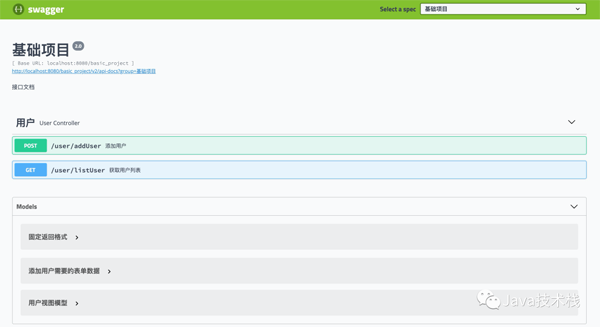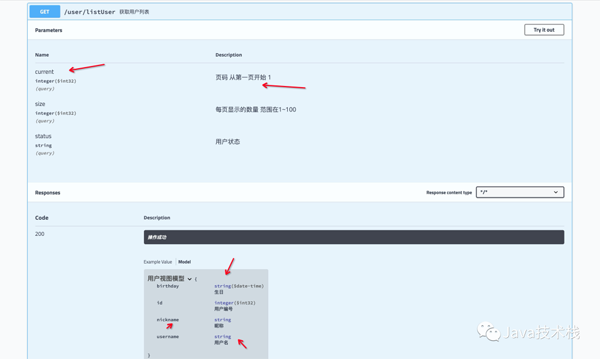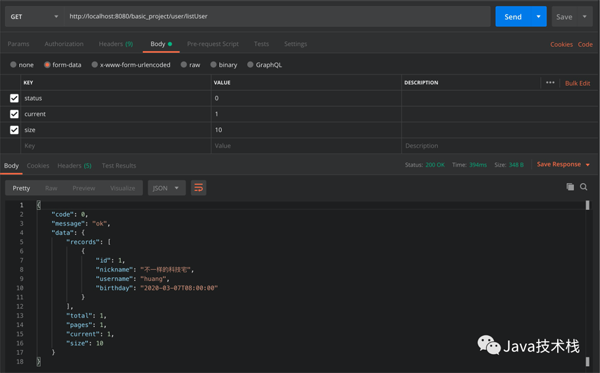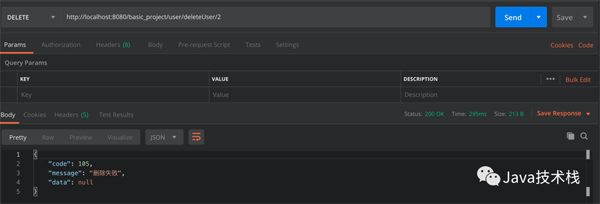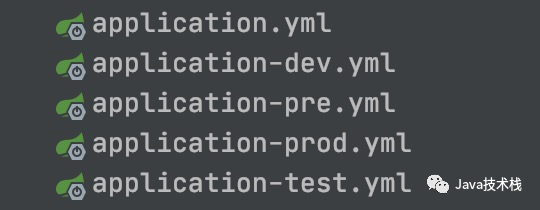一個Spring Boot項目該包含哪些?
前言
建立一個全新的項目,或者把舊的龐大的項目,進行拆分成多個項目。在建立新的項目中,經常需要做一些重復的工作,比如說拷貝一下常用的工具類,通用代碼等等。
所以就可以做一個基礎的項目方便使用,在經歷新項目的時候,直接在基礎項目上進行簡單配置就可以開發業務代碼了。
基礎項目該包含哪些東西。
- Swagger在線接口文檔。
- CodeGenerator 代碼生成器。
- 統一返回。
- 通用的分頁對象。
- 常用工具類。
- 全局異常攔截。
- 錯誤枚舉。
- 自定義異常。
- 多環境配置文件。
- Maven多環境配置。
- 日志配置。
- JenkinsFile。
Swagger
寫接口文檔通常是一件比較頭疼的事情,然而swagger就用是用來幫我們解決這個問題的。可以在線生成接口文檔,并且可以在頁面上進行測試。
可以非常清楚的顯示,請求數據已經響應數據。當然這一切都需要在代碼中進行配置。
「注意的點:接口文檔只能在測試/開發環境開啟,其他環境請關閉。」
常用的Swagger注解
- @Api用于Controller
- @ApiOperation用于Controller內的方法。
- @ApiResponses用于標識接口返回數據的類型。
- @ApiModel用于標識類的名稱
- @ApiModelProperty用于標識屬性的名稱
案例
- @RestController
- @Api(tags = "用戶")
- @AllArgsConstructor
- @RequestMapping("/user")
- public class UserController {
- private IUserService userService;
- /**
- * 獲取用戶列表
- * @param listUserForm 表單數據
- * @return 用戶列表
- */
- @ApiOperation("獲取用戶列表")
- @GetMapping("/listUser")
- @ApiResponses(
- @ApiResponse(code = 200, message = "操作成功", response = UserVo.class)
- )
- public ResultVo listUser(@Validated ListUserForm listUserForm){
- return ResultVoUtil.success(userService.listUser(listUserForm));
- }
- }
- @Data
- @ApiModel("獲取用戶列表需要的表單數據")
- @EqualsAndHashCode(callSuper = false)
- public class ListUserForm extends PageForm<ListUserForm> {
- /**
- * 用戶狀態
- */
- @ApiModelProperty("用戶狀態")
- @NotEmpty(message = "用戶狀態不能為空")
- @Range(min = -1 , max = 1 , message = "用戶狀態有誤")
- private String status;
- }
對應的swagger的配置可以查看基礎項目內的SwaggerConfiguration.java.點擊這里參考詳細教程。關注公眾號Java技術棧回復boot可以獲取Spring Boot系列教程。
CodeGenerator代碼生成器。
mybatis_plus代碼生成器可以幫我們生成entity,service,serviceImpl,mapper,mapper.xml。省去了建立一大堆實體類的麻煩。沒聽過的可以點擊這里參考這篇文章。
由于配置太長這里就不貼出來了,對應的CodeGenerator的配置可以查看基礎項目內的CodeGenerator.java.
常用的封裝
統一返回 ResultVo
將所有的接口的響應數據的格式進行統一。
- @Data
- @ApiModel("固定返回格式")
- public class ResultVo {
- /**
- * 錯誤碼
- */
- @ApiModelProperty("錯誤碼")
- private Integer code;
- /**
- * 提示信息
- */
- @ApiModelProperty("提示信息")
- private String message;
- /**
- * 具體的內容
- */
- @ApiModelProperty("響應數據")
- private Object data;
- }
抽象表單 BaseForm
- public abstract class BaseForm<T> {
- /**
- * 獲取實例
- * @return 返回實體類
- */
- public abstract T buildEntity();
- }
有小伙伴可能有疑問了,這個類有啥用呢。先看一下,下面的代碼。
- /**
- * 添加用戶
- * @param userForm 表單數據
- * @return true 或者 false
- */
- @Override
- public boolean addUser(AddUserForm userForm) {
- User user = new User();
- user.setNickname(userForm.getNickname());
- user.setBirthday(userForm.getBirthday());
- user.setUsername(userForm.getUsername());
- user.setPassword(userForm.getPassword());
- return save(user);
- }
重構一下,感覺清爽了一些。
- /**
- * 添加用戶
- * @param userForm 表單數據
- * @return true 或者 false
- */
- @Override
- public boolean addUser(AddUserForm userForm) {
- User user = new User();
- BeanUtils.copyProperties(this,user);
- return save(user);
- }
使用BaseForm進行重構 AddUserForm 繼承 BaseForm并重寫buildEntity
- @Data
- @EqualsAndHashCode(callSuper = false)
- public class AddUserForm extends BaseForm<User> {
- /**
- * 昵稱
- */
- private String nickname;
- /**
- * 生日
- */
- private Date birthday;
- /**
- * 用戶名
- */
- private String username;
- /**
- * 密碼
- */
- private String password;
- /**
- * 構造實體
- * @return 實體對象
- */
- @Override
- public User buildEntity() {
- User user = new User();
- BeanUtils.copyProperties(this,user);
- return user;
- }
- }
- /**
- * 添加用戶
- * @param userForm 表單數據
- * @return true 或者 false
- */
- @Override
- public boolean addUser(AddUserForm userForm) {
- return save(userForm.buildEntity());
- }
上面的代碼有沒有種似曾相識的感覺,很多情況都是將接受到的參數,轉變成對應的實體類然后「保存」或者「更新」。
所以對于這類的form可以繼承baseform并實現buildEntity()這樣可以更加符合面向對象,service不需要關心form如何轉變成entity,只需要在使用的時候調用buildEntity()即可,尤其是在form -> entity相對復雜的時候,這樣做可以減少service內的代碼。讓代碼邏輯看起來更加清晰。
通用的分頁對象
涉及到查詢的時候,絕大多數都需要用到分頁,所以說封裝分頁對象就很有必要。可以注意下 PageForm.calcCurrent()、PageVo.setCurrentAndSize()、PageVo.setTotal()這個幾個方法。
PageForm
- @Data
- @ApiModel(value = "分頁數據", description = "分頁需要的表單數據")
- public class PageForm<T extends PageForm<?>>{
- /**
- * 頁碼
- */
- @ApiModelProperty(value = "頁碼 從第一頁開始 1")
- @Min(value = 1, message = "頁碼輸入有誤")
- private Integer current;
- /**
- * 每頁顯示的數量
- */
- @ApiModelProperty(value = "每頁顯示的數量 范圍在1~100")
- @Range(min = 1, max = 100, message = "每頁顯示的數量輸入有誤")
- private Integer size;
- /**
- * 計算當前頁 ,方便mysql 進行分頁查詢
- * @return 返回 pageForm
- */
- @ApiModelProperty(hidden = true)
- public T calcCurrent(){
- current = (current - 1 ) * size;
- return (T) this;
- }
- }
PageVo
- @Data
- public class PageVo<T> {
- /**
- * 分頁數據
- */
- @ApiModelProperty(value = "分頁數據")
- private List<T> records;
- /**
- * 總條數
- */
- @ApiModelProperty(value = "總條數")
- private Integer total;
- /**
- * 總頁數
- */
- @ApiModelProperty(value = "總頁數")
- private Integer pages;
- /**
- * 當前頁
- */
- @ApiModelProperty(value = "當前頁")
- private Integer current;
- /**
- * 查詢數量
- */
- @ApiModelProperty(value = "查詢數量")
- private Integer size;
- /**
- * 設置當前頁和每頁顯示的數量
- * @param pageForm 分頁表單
- * @return 返回分頁信息
- */
- @ApiModelProperty(hidden = true)
- public PageVo<T> setCurrentAndSize(PageForm<?> pageForm){
- BeanUtils.copyProperties(pageForm,this);
- return this;
- }
- /**
- * 設置總記錄數
- * @param total 總記錄數
- */
- @ApiModelProperty(hidden = true)
- public void setTotal(Integer total) {
- this.total = total;
- this.setPages(this.total % this.size > 0 ? this.total / this.size + 1 : this.total / this.size);
- }
- }
案例
ListUserForm
- @Data
- @ApiModel("獲取用戶列表需要的表單數據")
- @EqualsAndHashCode(callSuper = false)
- public class ListUserForm extends PageForm<ListUserForm> {
- /**
- * 用戶狀態
- */
- @ApiModelProperty("用戶狀態")
- @NotEmpty(message = "用戶狀態不能為空")
- @Range(min = -1 , max = 1 , message = "用戶狀態有誤")
- private String status;
- }
UserServiceImpl
- /**
- * 獲取用戶列表
- * @param listUserForm 表單數據
- * @return 用戶列表
- */
- @Override
- public PageVo<UserVo> listUser(ListUserForm listUserForm) {
- PageVo<UserVo> pageVo = new PageVo<UserVo>().setCurrentAndSize(listUserForm);
- pageVo.setTotal(countUser(listUserForm.getStatus()));
- pageVo.setRecords(userMapper.listUser(listUserForm.calcCurrent()));
- return pageVo;
- }
- /**
- * 獲取用戶數量
- * @param status 狀態
- * @return 用戶數量
- */
- private Integer countUser(String status){
- return count(new QueryWrapper<User>().eq("status",status));
- }
UserController
- /**
- * 獲取用戶列表
- * @param listUserForm 表單數據
- * @return 用戶列表
- */
- @ApiOperation("獲取用戶列表")
- @GetMapping("/listUser")
- @ApiResponses(
- @ApiResponse(code = 200, message = "操作成功", response = UserVo.class)
- )
- public ResultVo listUser(@Validated ListUserForm listUserForm){
- return ResultVoUtil.success(userService.listUser(listUserForm));
- }
注意的點
- PageVo在實例化的時候需要設置「當前頁」和「每頁顯示的數量」 可以調用setCurrentAndSize()完成。
- 進行分頁查詢的時候,需要計算偏移量。listUserForm.calcCurrent()
為什么要計算偏移量呢?
- 假如查詢第1頁每頁顯示10條記錄,前端傳遞過來的參數是current=1&&size=10,這個時候limit 1,10沒有問題。
- 假如查詢第2頁每頁顯示10條記錄,前端傳遞過來的參數是current=2&&size=10,這個時候limit 2,10就有問題,實際應該是limit 10,10。calcCurrent()的作用就是如此。
為什么不用MybatisPlus自帶的分頁插件呢?
❝ 自帶的分頁查詢在大量數據下,會出現性能問題。 ❞
常用工具類
常用工具類可以根據自己的開發習慣引入。
推薦閱讀:國人開源了一款小而全的 Java 工具類庫
異常處理
異常處理的大致流程主要如下。
- 異常信息拋出 -> ControllerAdvice 進行捕獲格式化輸出內容
- 手動拋出CustomException并傳入ReulstEnum ——> 進行捕獲錯誤信息輸出錯誤信息。
自定義異常
- @Data
- @EqualsAndHashCode(callSuper = false)
- public class CustomException extends RuntimeException {
- /**
- * 狀態碼
- */
- private final Integer code;
- /**
- * 方法名稱
- */
- private final String method;
- /**
- * 自定義異常
- *
- * @param resultEnum 返回枚舉對象
- * @param method 方法
- */
- public CustomException(ResultEnum resultEnum, String method) {
- super(resultEnum.getMsg());
- this.code = resultEnum.getCode();
- this.method = method;
- }
- /**
- * @param code 狀態碼
- * @param message 錯誤信息
- * @param method 方法
- */
- public CustomException(Integer code, String message, String method) {
- super(message);
- this.code = code;
- this.method = method;
- }
- }
錯誤信息枚舉
根據業務進行添加。
- @Getter
- public enum ResultEnum {
- /**
- * 未知異常
- */
- UNKNOWN_EXCEPTION(100, "未知異常"),
- /**
- * 添加失敗
- */
- ADD_ERROR(103, "添加失敗"),
- /**
- * 更新失敗
- */
- UPDATE_ERROR(104, "更新失敗"),
- /**
- * 刪除失敗
- */
- DELETE_ERROR(105, "刪除失敗"),
- /**
- * 查找失敗
- */
- GET_ERROR(106, "查找失敗"),
- ;
- private Integer code;
- private String msg;
- ResultEnum(Integer code, String msg) {
- this.code = code;
- this.msg = msg;
- }
- /**
- * 通過狀態碼獲取枚舉對象
- * @param code 狀態碼
- * @return 枚舉對象
- */
- public static ResultEnum getByCode(int code){
- for (ResultEnum resultEnum : ResultEnum.values()) {
- if(code == resultEnum.getCode()){
- return resultEnum;
- }
- }
- return null;
- }
- }
全局異常攔截
全局異常攔截是使用@ControllerAdvice進行實現,常用的異常攔截配置可以查看 GlobalExceptionHandling。
- @Slf4j
- @RestControllerAdvice
- public class GlobalExceptionHandling {
- /**
- * 自定義異常
- */
- @ExceptionHandler(value = CustomException.class)
- public ResultVo processException(CustomException e) {
- log.error("位置:{} -> 錯誤信息:{}", e.getMethod() ,e.getLocalizedMessage());
- return ResultVoUtil.error(Objects.requireNonNull(ResultEnum.getByCode(e.getCode())));
- }
- /**
- * 通用異常
- */
- @ResponseStatus(HttpStatus.OK)
- @ExceptionHandler(Exception.class)
- public ResultVo exception(Exception e) {
- e.printStackTrace();
- return ResultVoUtil.error(ResultEnum.UNKNOWN_EXCEPTION);
- }
- }
案例
Controller
- /**
- * 刪除用戶
- * @param id 用戶編號
- * @return 成功或者失敗
- */
- @ApiOperation("刪除用戶")
- @DeleteMapping("/deleteUser/{id}")
- public ResultVo deleteUser(@PathVariable("id") String id){
- userService.deleteUser(id);
- return ResultVoUtil.success();
- }
Service
- /**
- * 刪除用戶
- * @param id id
- */
- @Override
- public void deleteUser(String id) {
- // 如果刪除失敗拋出異常。 -- 演示而已不推薦這樣干
- if(!removeById(id)){
- throw new CustomException(ResultEnum.DELETE_ERROR, MethodUtil.getLineInfo());
- }
- }
結果
「將報錯代碼所在的文件第多少行都打印出來。方便排查。」
注意的點
所有手動拋出的錯誤信息,都應在錯誤信息枚舉ResultEnum進行統一維護。不同的業務使用不同的錯誤碼。方便在報錯時進行分辨。快速定位問題。
多環境配置
SpringBoot多環境配置
對于一個項目來講基本都4有個環境dev,test,pre,prod,對于SpringBoot項目多建立幾個配置文件就可以了。
然后啟動的時候可以通過配置spring.profiles.active 來選擇啟動的環境。這個詳細教程請關注公眾號Java技術棧回復boot獲取系列教程。
- java -jar BasicProject.jar --spring.profiles.active=prod
Maven多環境配置
假如想在打包的時候動態指定環境,這個時候就需要借助Maven的xml來實現。這個請關注公眾號Java技術棧回復mvn獲取一份完整詳細教程。
配置XML
- <!-- 配置環境 -->
- <profiles>
- <profile>
- <!-- 開發 -->
- <id>dev</id>
- <activation>
- <activeByDefault>true</activeByDefault>
- </activation>
- <properties>
- <activatedProperties>dev</activatedProperties>
- </properties>
- </profile>
- <profile>
- <!-- 測試 -->
- <id>test</id>
- <properties>
- <activatedProperties>test</activatedProperties>
- </properties>
- </profile>
- <profile>
- <!-- 準生產 -->
- <id>pre</id>
- <properties>
- <activatedProperties>pre</activatedProperties>
- </properties>
- </profile>
- <profile>
- <!-- 生產 -->
- <id>prod</id>
- <properties>
- <activatedProperties>prod</activatedProperties>
- </properties>
- </profile>
- </profiles>
更改application.yml
- spring:
- profiles:
- # 選擇環境
- active: @activatedProperties@
使用案例
- mvn clean package -P prod
- mvn clean package -P pre
- mvn clean package -P test
打包完可以解壓開查看application.yml 會發現spring.profiles.active=@activatedProperties@ 發生了改變。
日志配置
采用logback日志配置,點擊這里參考這篇文章。
JenkinsFile
JenkinsFile肯定顧名思義是給jenkins用的。主要是配置項目根據如何進行構建并發布到不同的環境。需要去了解pipeline語法,以及如何配置jenkins。
結尾
如果覺得對你有幫助,可以隨手點個在看哦,謝謝。














